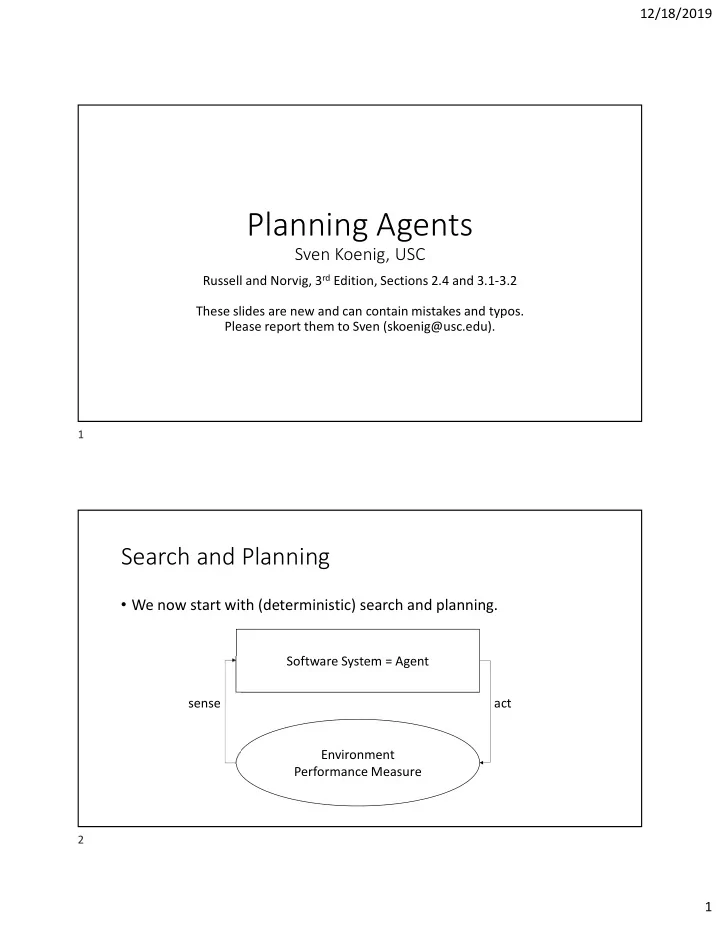

12/18/2019 Planning Agents Sven Koenig, USC Russell and Norvig, 3 rd Edition, Sections 2.4 and 3.1-3.2 These slides are new and can contain mistakes and typos. Please report them to Sven (skoenig@usc.edu). 1 Search and Planning • We now start with (deterministic) search and planning. Software System = Agent sense act Environment Performance Measure 2 1
12/18/2019 Architectures for Planning Agents Sensor interpretation Effector control table sequence of all next Percepts Effectors Sensors Actions sequence of all past percepts action past percepts and actions and actions 3 Architectures for Planning Agents • Gold standard (but: results in a large table that is difficult to change) Sensor interpretation table Effector control sequence of all next Percepts Effectors Sensors Actions sequence of all past percepts action past percepts and actions and actions 4 2
12/18/2019 Architectures for Planning Agents Sensor interpretation Effector control Percepts Effectors Sensors Actions program 5 Architectures for Planning Agents • Reflex agent (“reactive planning”): often good for video games Sensor interpretation Effector control Percepts Effectors Sensors Actions program 6 3
12/18/2019 Architectures for Planning Agents • An agent often does not need to remember the sequence of past percepts and actions to perform well according to its performance objective. • A state characterizes the information that an agent needs to have about the past and present to pick actions in the future to perform well according to its performance objective. • We are typically interested in minimal states. • For example, a soda machine does not need to remember in which order coins were inserted and in which order coins and products were returned in the past. It only needs to remember the total amount of money inserted by the current customer. 7 Architectures for Planning Agents Sensor interpretation Effector control Percepts Effectors Sensors Actions state program 8 4
12/18/2019 Architectures for Planning Agents • Planning agent goal states Sensor interpretation (or performance measure) Effector control Percepts Effectors Sensors Actions program state 9 Examples • What are the states, actions and action costs? • Eight puzzle 1 3 2 1 2 3 5 6 4 5 6 7 8 4 7 8 start (= current) configuration goal configuration 10 5
12/18/2019 Examples • What are the states, actions and action costs? • Missionaries and cannibals problem Three missionaries and three cannibals are on the left side of a river, along with a boat that can hold one or two people. Find the quickest way to get everyone to the other side, without ever leaving a group of missionaries in one place outnumbered by the cannibals in that place. 11 Examples • What are the states, actions and action costs? • Traveling salesperson problem Visit all given cities in the plane with a shortest tour (= with the smallest round-trip distance). 12 6
12/18/2019 start state 1 3 2 5 6 State Spaces 7 8 4 empty up: cost 1 empty down: cost 1 empty left: cost 1 1 3 1 3 2 1 3 2 5 6 2 5 6 5 6 4 7 8 4 7 8 4 7 8 1 3 2 1 3 1 2 1 3 2 1 3 2 5 6 4 5 6 2 5 3 6 5 6 5 8 6 7 4 7 8 7 8 4 7 8 4 7 8 4 … 1 2 3 1 2 3 4 5 4 5 6 7 8 6 7 8 empty down: cost 1 empty right: cost 1 1 2 3 4 5 6 7 8 goal state 13 State Spaces • Example application of hillclimbing: Boolean satisfiability • Find an interpretation that makes a given propositional sentence true. • Transform the propositional sentence into conjunctive normal form, assign random truth values to all propositional symbols, then repeatedly switch the truth value of some symbol to decrease the number of clauses that evaluate to false. • S ≡ (P OR Q) AND (NOT P OR NOT R) AND (P OR NOT Q OR R) start state = assignment of random truth values to all propositional symbols P, NOT Q, R flip P flip Q flip R P, Q, R P, NOT Q, NOT R NOT P, NOT Q, R … • Costs do not matter since we are not interested in finding a minimum-cost path. • There is more than one goal state, e.g. P, Q, NOT R and P, NOT Q, NOT R. • There is a goal test, namely whether S is true. 14 7
12/18/2019 State Spaces • Graph • State space • Vertex • State • Edge • Action = operator = successor function succ(s,s’) ε States • Edge cost • Action cost = operator cost • Start vertex • Start state • Goal vertex • Goal state or goal test goal(s) ε {true, false} • Solution is a • Solution is a (minimum-cost) (minimum-cost) path action sequence = operator sequence from the start vertex from the start state to any goal vertex to any goal state 15 8
Recommend
More recommend